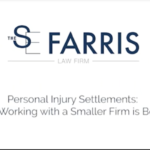You have probably seen the very well done ads of Florida law firm Morgan and Morgan that declare bigger is better for law firms. Brown and Crouppen ran similar ads before Morgan and Morgan came to town.
If you want cheap toothpaste or toilet paper, big box stores win on price. For injury victims needing a lawyer however, big box is not the way to go. To understand why, you need to know how the business of law firms works.
In the injury law space, there are two ways that law firms get paid. The insurance company lawyers bill by the hour. That means that the longer they drag out a case, the more money they make. Insurance companies are on board with this strategy because if they can delay payment long enough, the injury victim might never collect.
No one plans to be an injured plaintiff, and few have cash for an hourly rate attorney. Therefore, lawyers representing plaintiffs charge a percentage of recovery, or a contingent fee. This percentage ranges from 25 to 40%, with 33 1/3% being the most common. As you can see, the plaintiff’s attorney’s hourly rate depends on how much time is spent on the case.
This metric is called “time on desk” and it means how long a case spends in the law office between sign up and settlement. Cases that spend less time on desk are more profitable for the law firm. Here is how that works against the injury victim who hires a big box law firm.
Assume for a moment that the average injury case is worth $30,000– to keep the math simple.
The 1/3 attorney fee translates to $10,000 and can take an average of 2 years before the lawyer gets paid. If that case goes all the way to trial, the lawyer will have spent about 100 hours on the case for an effective hourly rate of $100 per hour. If the case settles without a trial, the hourly rate jumps to about $200 per hour. The client would get about $20,000 towards recovering their damages.
Big firms represent thousands of clients at a time and can’t afford to try all of those cases. Very few lawyers at big box firms have ever even tried a case, and insurance companies know that they don’t have to pay top dollar if a trial isn’t likely.
But that isn’t the only reason big box law firm clients get lower settlements. Like all businesses, big box lawfirms have to maintain positive cash flow, meaning money has to come in to the firm on a regular basis to pay all of the advertising bills and employee salaries.
In order to maintain cash flow, big box firms have to settle their clients’ cases quickly and minimize the time on desk. Accepting 80 cents on the dollar means the $30,000 case settles for $24,000 and the law firm gets $8,000. Cheap settlements can happen quickly, which means even less time on desk so that the average case is over in around a year, with 20-40 hours of lawyer time at $200-400 per hour. Meanwhile, the client gets $16,000.
Multiply that by thousands of cases and you can see why the big law firms can afford multimillion dollar advertising budgets. Smaller firms that don’t have that pressure can afford to prepare cases for trial so that the clients get more of their damages back.
Another important element is the client to lawyer ratio. If I limit the amount of clients I represent to a hundred or even two hundred, I can work on every case every month. I also don’t have any settlement quotas to meet because my name is on the door and I am accountable to all of my clients directly. Lawyers with thousands of clients can’t say that.
If you need toothpaste or toilet paper, the big box store is where you can find a deal. If you have been injured, you have one chance to recover your losses. You shouldn’t waste that chance on a big box lawyer.
Call our St. Louis law firm to schedule an initial consultation, where you will receive free legal advice from a personal injury lawyer near you.
Check out our video series on this topic:





